Abstract
Respiratory muscle function was assessed in six patients with the Lambert-Eaton myasthenic syndrome. Five had histologically proved small cell carcinoma of the lung; the sixth later developed metastases from an unknown primary site. Two patients had ventilatory failure, one without respiratory symptoms; another, who had emphysema, had dyspnoea and orthopnoea. The remaining three patients had no respiratory symptoms. Four patients had limb muscle weakness as judged by the maximal voluntary contraction of the quadriceps muscle (range for all subjects 32-100% predicted). Transdiaphragmatic pressure (Pdi) was measured during a maximal unoccluded sniff (Pdi: sniff), a maximal sustained inspiratory effort against a closed airway (Pdi: Pimax), and phrenic nerve stimulation (Pdi: twitch). Mild to moderate diaphragmatic weakness was present in all six patients in proportion to the degree of leg weakness (Pdi: sniff 30-64% predicted; r = 0.6; Pdi:Pimax 6-69% predicted, r = 0.8); this was associated with very low or absent Pdi:twitch during phrenic nerve stimulation. Four patients had weakness of the expiratory muscles. Improvement in muscle strength was documented in two patients after tumour chemotherapy and specific treatment with 3,4-diaminopyridine and prednisolone; one patient was still alive five years from first diagnosis. It is concluded that the respiratory muscles may be implicated in this condition more often than has previously been recognised. As the lack of mobility may cause respiratory symptoms to be minimised, the presence of respiratory muscle weakness may remain undiagnosed unless formal measurement of respiratory muscle function is made.
Full text
PDF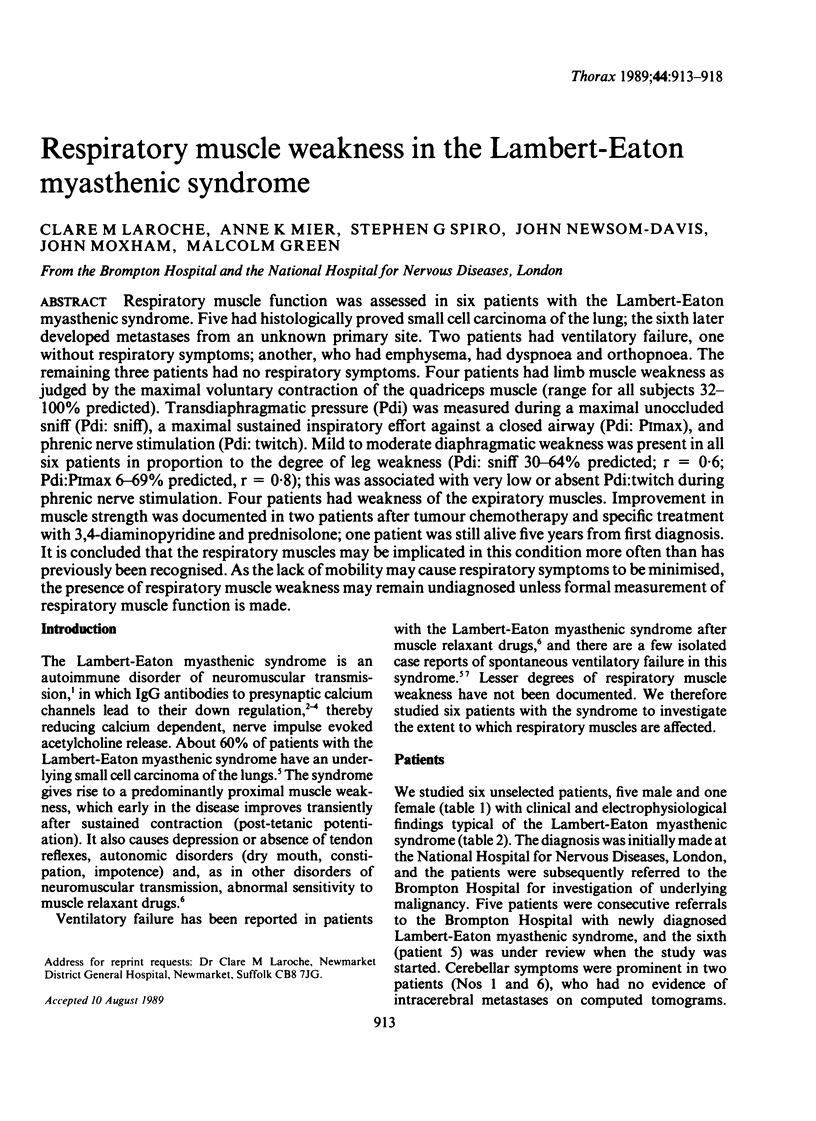
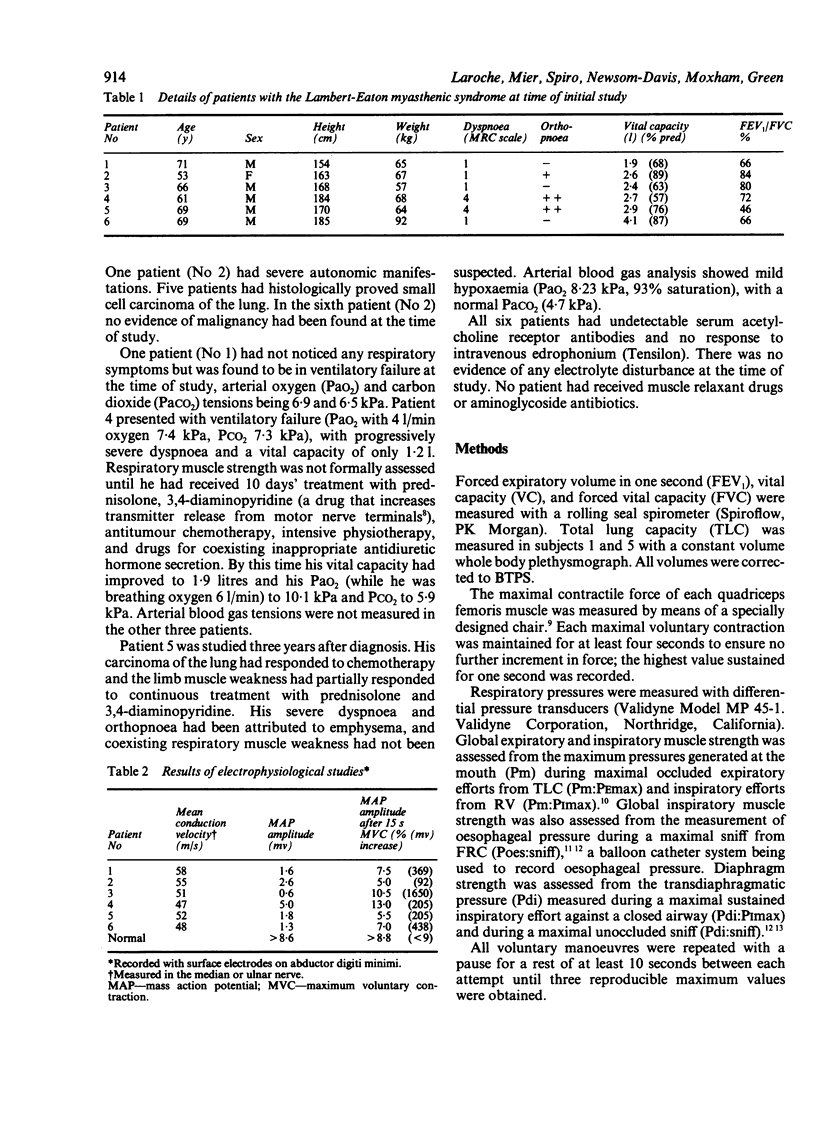
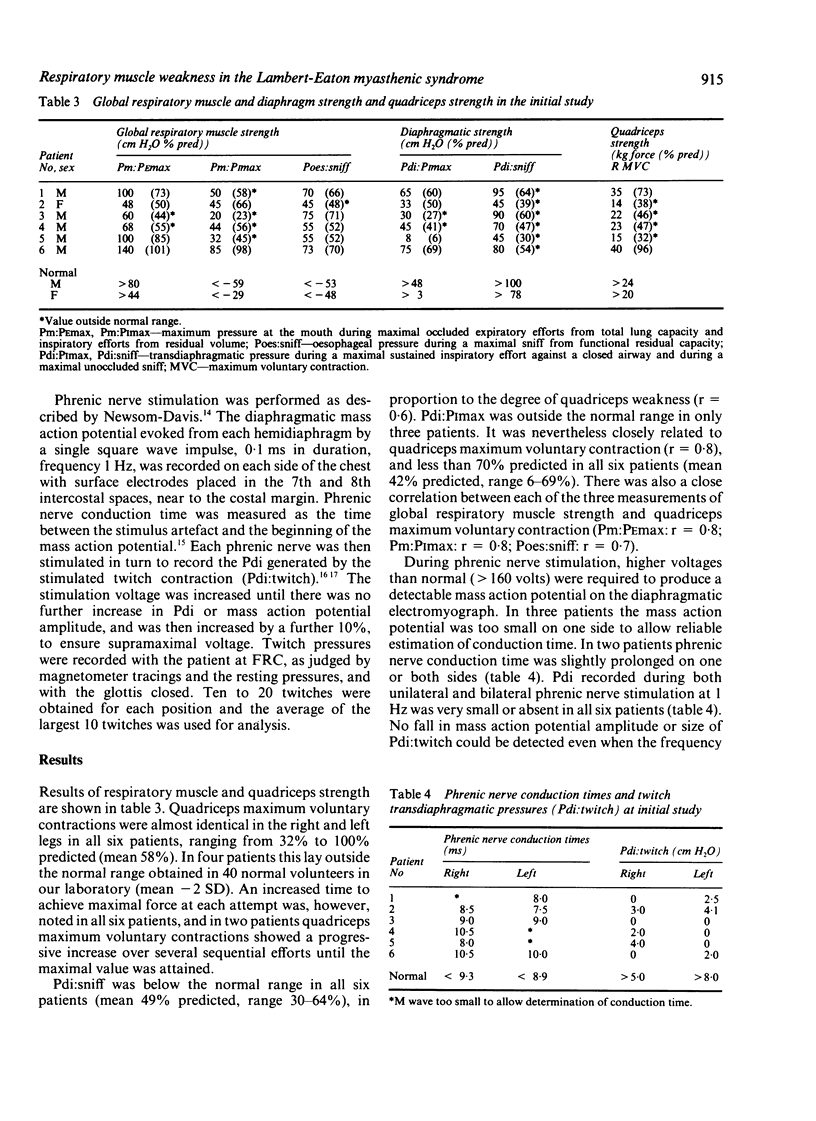
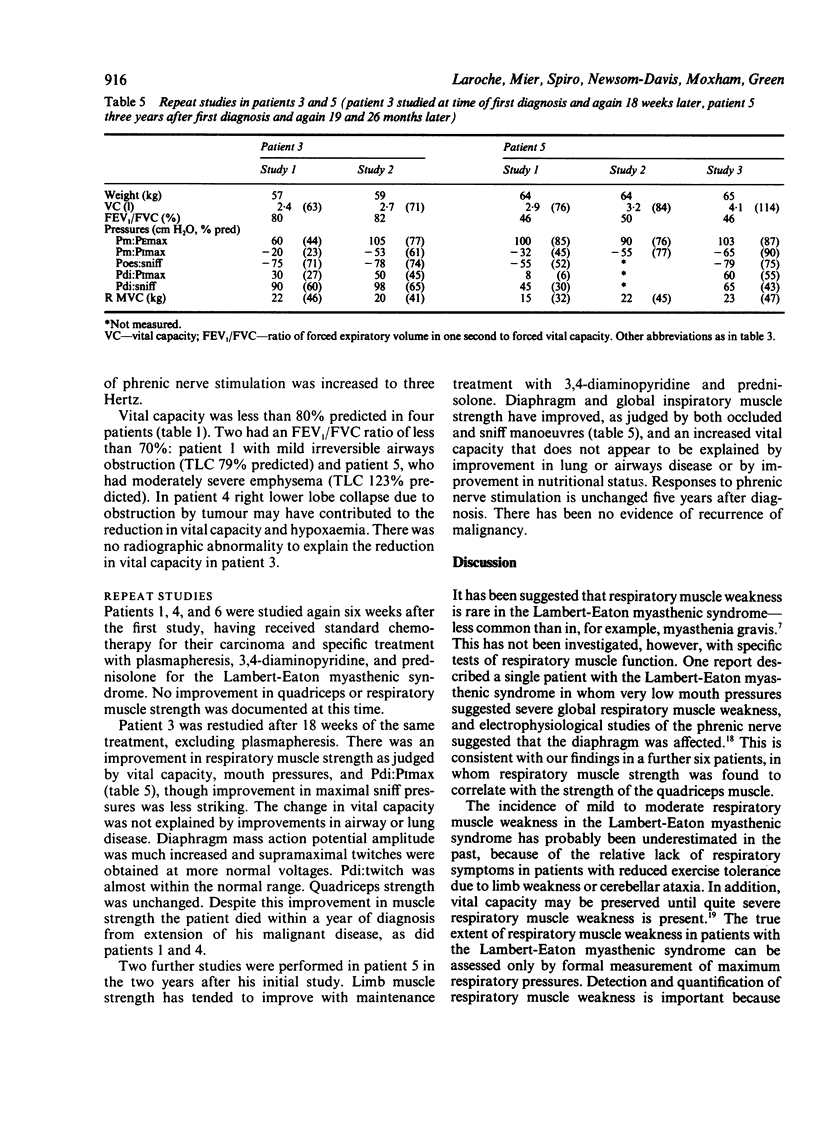
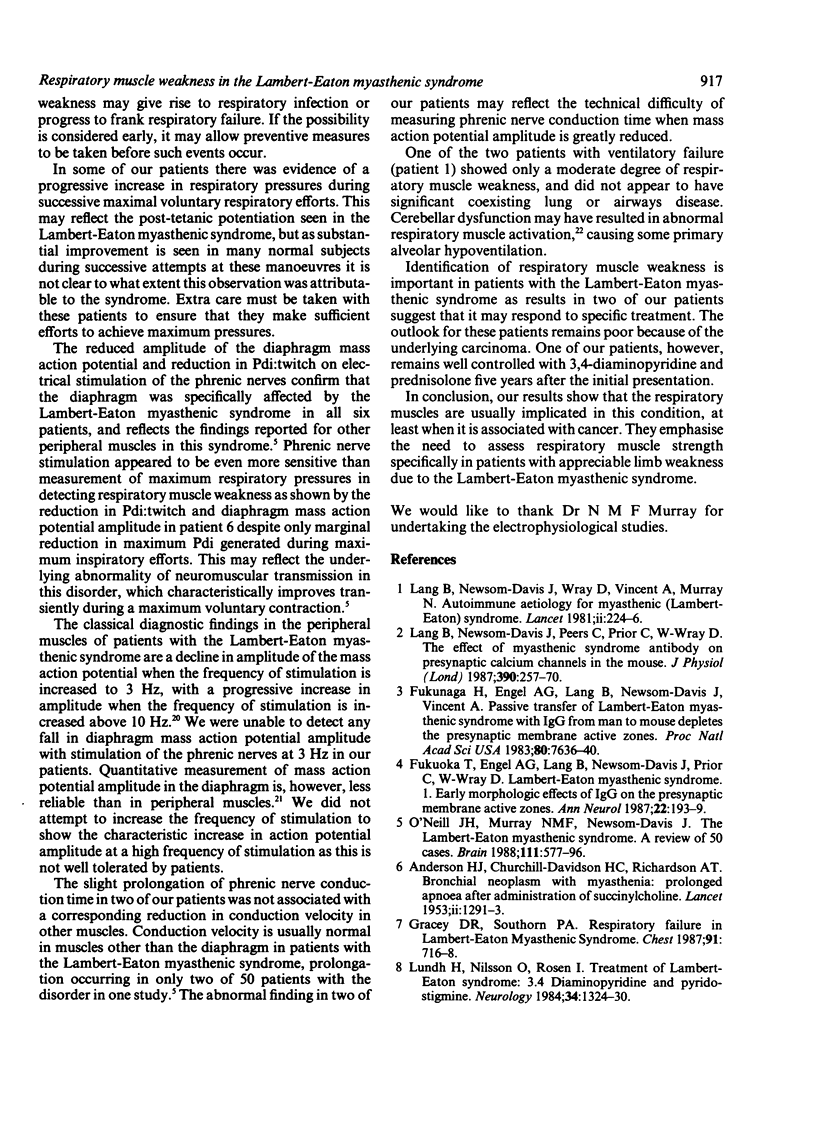
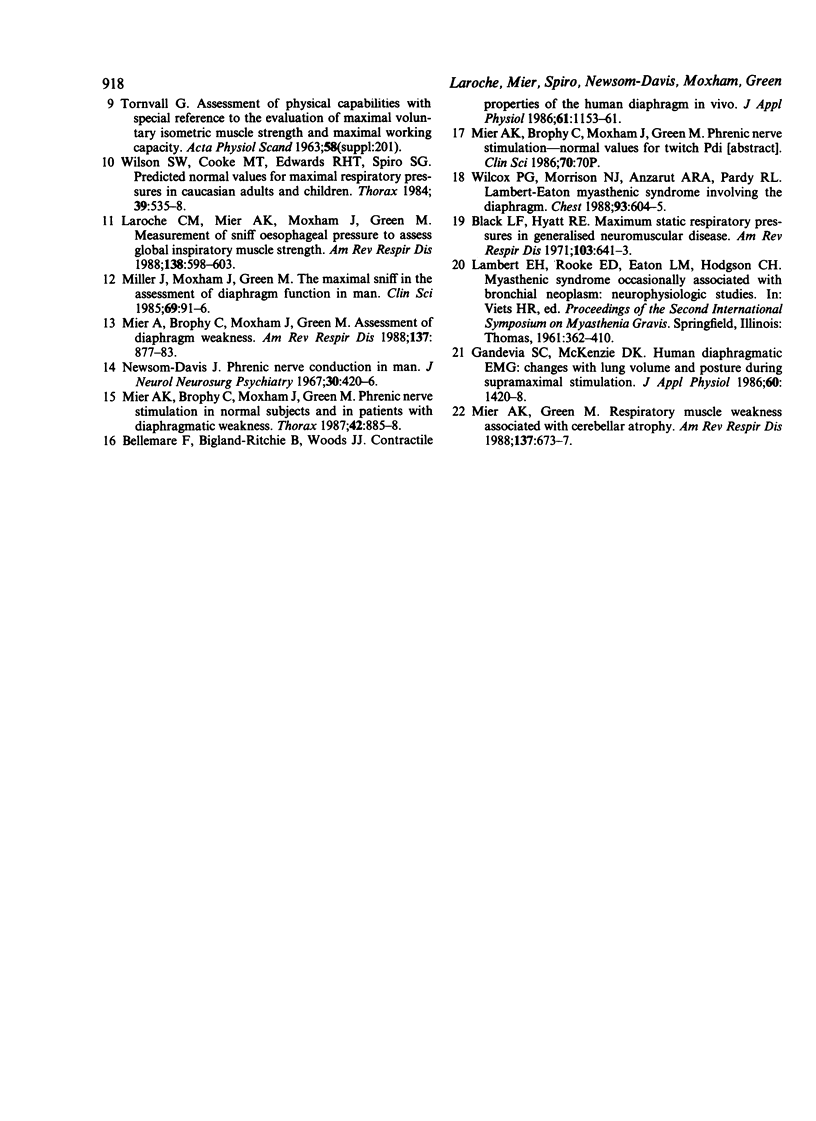
Selected References
These references are in PubMed. This may not be the complete list of references from this article.
- ANDERSON H. J., CHURCHILL-DAVIDSON H. C., RICHARDSON A. T. Bronchial neoplasm with myasthenia; prolonged apnoea after administration of succinylcholine. Lancet. 1953 Dec 19;265(6799):1291–1293. doi: 10.1016/s0140-6736(53)91358-0. [DOI] [PubMed] [Google Scholar]
- Bellemare F., Bigland-Ritchie B., Woods J. J. Contractile properties of the human diaphragm in vivo. J Appl Physiol (1985) 1986 Sep;61(3):1153–1161. doi: 10.1152/jappl.1986.61.3.1153. [DOI] [PubMed] [Google Scholar]
- Black L. F., Hyatt R. E. Maximal static respiratory pressures in generalized neuromuscular disease. Am Rev Respir Dis. 1971 May;103(5):641–650. doi: 10.1164/arrd.1971.103.5.641. [DOI] [PubMed] [Google Scholar]
- Davis J. N. Phrenic nerve conduction in man. J Neurol Neurosurg Psychiatry. 1967 Oct;30(5):420–426. doi: 10.1136/jnnp.30.5.420. [DOI] [PMC free article] [PubMed] [Google Scholar]
- Fukunaga H., Engel A. G., Lang B., Newsom-Davis J., Vincent A. Passive transfer of Lambert-Eaton myasthenic syndrome with IgG from man to mouse depletes the presynaptic membrane active zones. Proc Natl Acad Sci U S A. 1983 Dec;80(24):7636–7640. doi: 10.1073/pnas.80.24.7636. [DOI] [PMC free article] [PubMed] [Google Scholar]
- Fukuoka T., Engel A. G., Lang B., Newsom-Davis J., Prior C., Wray D. W. Lambert-Eaton myasthenic syndrome: I. Early morphological effects of IgG on the presynaptic membrane active zones. Ann Neurol. 1987 Aug;22(2):193–199. doi: 10.1002/ana.410220203. [DOI] [PubMed] [Google Scholar]
- Gandevia S. C., McKenzie D. K. Human diaphragmatic EMG: changes with lung volume and posture during supramaximal phrenic stimulation. J Appl Physiol (1985) 1986 Apr;60(4):1420–1428. doi: 10.1152/jappl.1986.60.4.1420. [DOI] [PubMed] [Google Scholar]
- Gracey D. R., Southorn P. A. Respiratory failure in Lambert-Eaton myasthenic syndrome. Chest. 1987 May;91(5):716–718. doi: 10.1378/chest.91.5.716. [DOI] [PubMed] [Google Scholar]
- Lang B., Newsom-Davis J., Peers C., Prior C., Wray D. W. The effect of myasthenic syndrome antibody on presynaptic calcium channels in the mouse. J Physiol. 1987 Sep;390:257–270. doi: 10.1113/jphysiol.1987.sp016698. [DOI] [PMC free article] [PubMed] [Google Scholar]
- Lang B., Newsom-Davis J., Wray D., Vincent A., Murray N. Autoimmune aetiology for myasthenic (Eaton-Lambert) syndrome. Lancet. 1981 Aug 1;2(8240):224–226. doi: 10.1016/s0140-6736(81)90474-8. [DOI] [PubMed] [Google Scholar]
- Laroche C. M., Mier A. K., Moxham J., Green M. The value of sniff esophageal pressures in the assessment of global inspiratory muscle strength. Am Rev Respir Dis. 1988 Sep;138(3):598–603. doi: 10.1164/ajrccm/138.3.598. [DOI] [PubMed] [Google Scholar]
- Lundh H., Nilsson O., Rosén I. Treatment of Lambert-Eaton syndrome: 3,4-diaminopyridine and pyridostigmine. Neurology. 1984 Oct;34(10):1324–1330. doi: 10.1212/wnl.34.10.1324. [DOI] [PubMed] [Google Scholar]
- Mier-Jedrzejowicz A., Brophy C., Moxham J., Green M. Assessment of diaphragm weakness. Am Rev Respir Dis. 1988 Apr;137(4):877–883. doi: 10.1164/ajrccm/137.4.877. [DOI] [PubMed] [Google Scholar]
- Mier-Jedrzejowicz A., Green M. Respiratory muscle weakness associated with cerebellar atrophy. Am Rev Respir Dis. 1988 Mar;137(3):673–677. doi: 10.1164/ajrccm/137.3.673. [DOI] [PubMed] [Google Scholar]
- Mier A., Brophy C., Moxham J., Green M. Phrenic nerve stimulation in normal subjects and in patients with diaphragmatic weakness. Thorax. 1987 Nov;42(11):885–888. doi: 10.1136/thx.42.11.885. [DOI] [PMC free article] [PubMed] [Google Scholar]
- Miller J. M., Moxham J., Green M. The maximal sniff in the assessment of diaphragm function in man. Clin Sci (Lond) 1985 Jul;69(1):91–96. doi: 10.1042/cs0690091. [DOI] [PubMed] [Google Scholar]
- O'Neill J. H., Murray N. M., Newsom-Davis J. The Lambert-Eaton myasthenic syndrome. A review of 50 cases. Brain. 1988 Jun;111(Pt 3):577–596. doi: 10.1093/brain/111.3.577. [DOI] [PubMed] [Google Scholar]
- Wilcox P. G., Morrison N. J., Anzarut A. R., Pardy R. L. Lambert-Eaton myasthenic syndrome involving the diaphragm. Chest. 1988 Mar;93(3):604–606. doi: 10.1378/chest.93.3.604. [DOI] [PubMed] [Google Scholar]
- Wilson S. H., Cooke N. T., Edwards R. H., Spiro S. G. Predicted normal values for maximal respiratory pressures in caucasian adults and children. Thorax. 1984 Jul;39(7):535–538. doi: 10.1136/thx.39.7.535. [DOI] [PMC free article] [PubMed] [Google Scholar]


